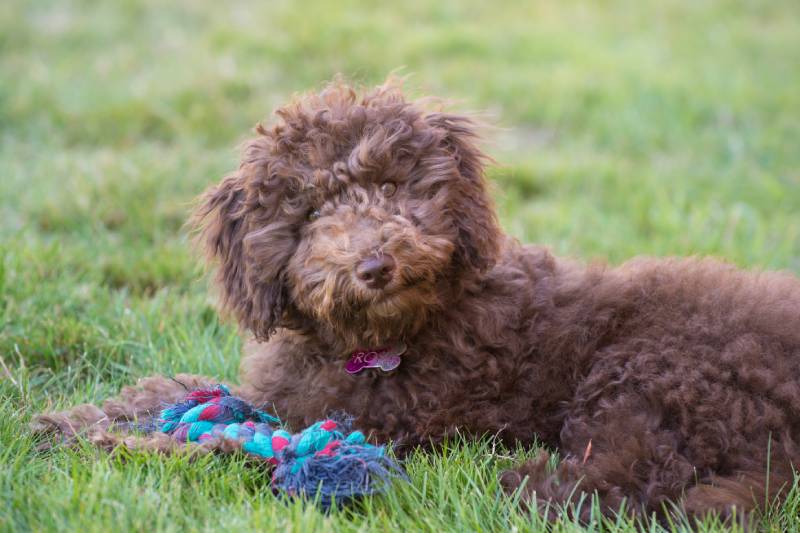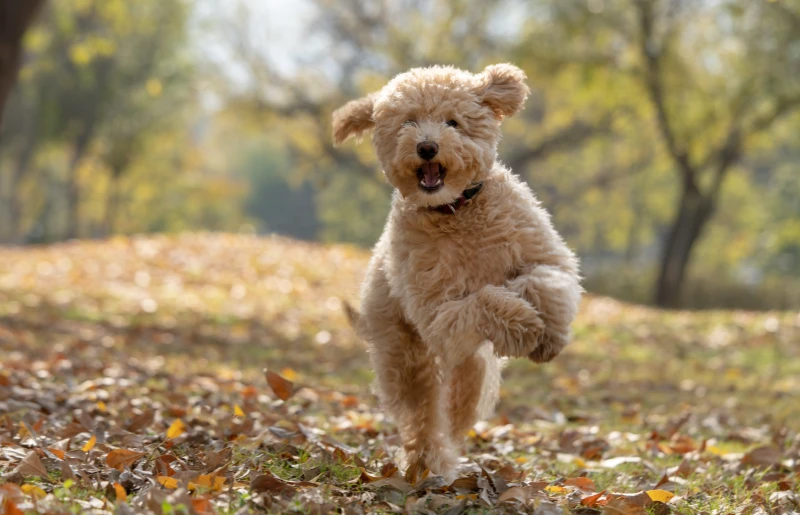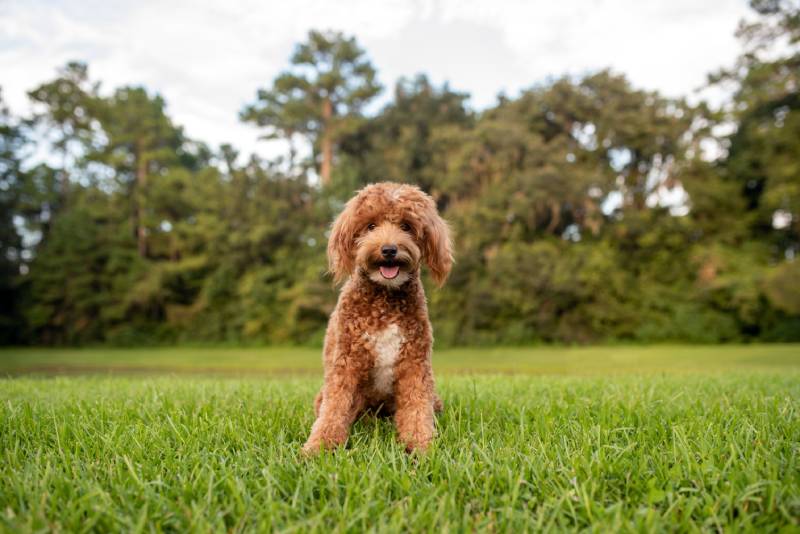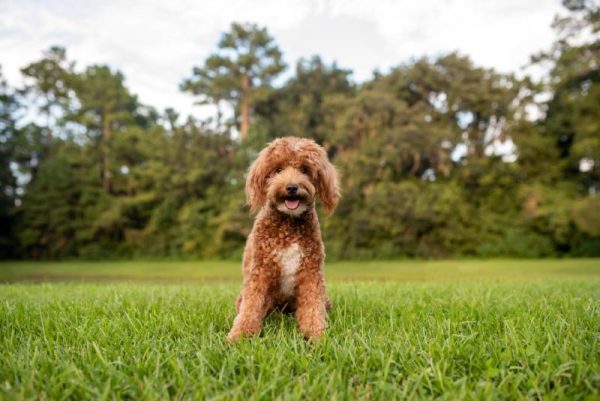The more you research, the more you understand why doodle mixes are becoming increasingly popular. Bringing home a dog is a serious decision you want to get right the first time. Marrying the best qualities of the Poodle with family-friendly breeds, designer dogs like the Mini Goldendoodle seem like a can’t-miss proposition.
But expecting a perfect fit with the family can easily set you up for disappointment. Though there’s plenty to love about the Mini Goldendoodle, they require commitment and understanding. Appreciating their needs is crucial if you hope for a happy and healthy relationship.
You, your family, and your future pet deserve a thoughtful decision when you’re ready for your next dog, and that’s only possible with an honest look at the ups and downs of each breed. To help you ensure the most fulfilling ownership experience, we’ll explore the pros and cons of living with a Mini Goldendoodle.
The 5 Mini Goldendoodle Pros
1. Smaller Size
Mini Goldendoodles are around 13–20 inches tall and weigh 15–35 pounds. They’re substantially smaller than the standard Goldendoodle, which can weigh up to 90 pounds and reach heights of 21–24 inches.
When looking for all the benefits of a Goldendoodle in a manageable package, less is more. The Mini Goldendoodle’s small size means more adaptability, flexibility, and money saved on supplies. They eat less food than their parent breeds, use smaller equipment, are easier to lift, and don’t demand much space, giving you more physical and financial wiggle room.
More importantly, Mini Goldendoodles are incredibly versatile. They can fit in almost anywhere. Take them to the country or a city apartment, and they’ll have no problem making the most of their space. Mini Goldendoodles also travel easily, using little room and supplying a gung-ho attitude and bright personality that can be a joy to have on the road.

2. Low Shedding
The draw of any Poodle mixed breed is their compatibility with allergy sufferers. Doodles inherit much of the Poodle parent’s low shedding qualities, making them some of the cleaner dogs for the house. It can be a perfect solution for those who adore the Golden Retriever temperament but can do without that explosion of fur.
The filial rating makes a difference in the hunt for a low-shedding mix. First-generation F1 mixes (50% Golden Retriever, 50% Poodle) are relatively low-shedding pets. But a backcrossed F1B (50% Poodle, 50% Goldendoodle) has 75% of its genetics (and more coat characteristics) from the Poodle, meaning even less shedding. Breeders offer various generational mixes, with the F1B being the most popular.
3. Exceptional Family Pet
Outside of the shedding, you’ll have difficulty finding fault with the Golden Retriever. The trusting, playful, and easy-to-train breed can immediately get along with anyone, whether it’s a stranger at the door, a dog at the park, or a new pet in the home. Intelligent, joyous, and active, they are excellent companions for adults and children alike, making it clear why they’re among the country’s top three dog breeds.
When you mix that outgoing and devoted personality with a Poodle’s shed-free fur, you’ve overcome the biggest obstacle to owning one. And a low-allergen coat isn’t all the Mini Poodle brings to the party.
Poodles have a reputation as one of the most intelligent breeds. They are highly biddable and fun to train while still being extremely affectionate with the whole family. In a miniature size, you get a dog even more well-suited for children. On the one hand, they’re smaller than Goldens and less likely to hurt a child during play.
At the same time, they’re more sizable than a Mini Poodle, making them sturdier in the face of awkward handling. Dogs and children need supervision, but Mini Goldendoodles shouldn’t have an issue developing deep, positive bonds with children of any age.

4. Excellent For First-Time Owners
Bringing two intelligent dogs together in one mixed breed is more of a challenge than a help when you get a stubborn and dominant personality. But with a Mini Goldendoodle, that high intelligence naturally works in a positive, people-pleasing direction, making this designer dog one of the best options for inexperienced new owners.
There’s little to catch you off guard with a Mini Goldendoodle. While many first-time dog owners feel overwhelmed by unexpected health issues, demanding exercise requirements, or clinginess, Mini Goldendoodles offer relief on nearly all fronts.
Mini Goldendoodles are easy to train and adaptable, presenting few surprises when you bring them home. They get along well with everyone, and although Poodles and Golden Retrievers are energetic, the miniature mix won’t demand as much intensive exercise. Except for their grooming needs, a Mini Goldendoodle’s core characteristics can fit seamlessly with any pre-existing routine.
5. Availability
Mixed-breed dogs from reputable sources aren’t as easy to find as purebreds. Despite the notion that bringing two breeds together marries their best qualities, mixes aren’t particularly popular. You’ll have trouble finding specific crosses anywhere other than in a shelter.
The product of uncontrolled breeding in most cases, mixed breed dogs often have an uncertain background. Unlike purebreds, you can’t be sure of inheritable diseases, breed mixture, or temperament, making it harder to predict your ownership experience.
But that isn’t the case with doodle mixes. With their distinct benefits, dogs like Goldendoodles, Bernedoodles, and Cockapoos have exploded in popularity, inspiring a new line of dedicated breeders. Today, you can find Mini Goldendoodle breeders across the country offering dependably healthy puppies with the complete package of testing and support.

The 4 Mini Goldendoodle Cons
6. More Maintenance Than You Might Think
A United States survey of designer dog owners offers a mixed set of expectations for prospective parents. The low-shedding coat is the primary appeal of owning a doodle, but if you think that entails easy maintenance, you’ll be as disappointed as roughly one-quarter of doodle owners found their pups had far more intensive grooming needs than they realized.
Mini Goldendoodles may not shed much, but their hair demands frequent attention. Tangles and mats are a common problem with their twisty coats. Daily brushing is necessary to relieve knots and remove dead hair and debris. Owners will have to take their pet to the groomer once every 1–2 months, making them more expensive to maintain than dogs with short, straight hair.
7. Not Hypoallergenic
We can’t mention a doodle’s low-shedding coat without repeating the old line that no dog is 100% hypoallergenic. While they may not release as much dander because of their nominal shedding, the truth is that doodles like the Mini Goldendoodle can be just as irritating to allergy sufferers as the next dog.
Despite the hypoallergenic label, dog breeds like Poodles and Spanish Waterdogs can release as much, if not more, of the Can f 1 allergen, the primary allergen in canines. You’ll love having less hair floating around the house, but a doodle doesn’t guarantee any escape from the itchy eyes, runny nose, and asthma-like signs that come with common dog allergies.
Interestingly, the Poodle may be the worst part of the Mini Goldendoodle for allergy sufferers. While Poodles ranked as having relatively high levels of the Can f 1 allergen, the Golden Retriever had one of the lower levels. Poodles may not be the best choice, but designer breeds like the Mini Goldendoodle and Labradoodle offer a better blend of being less allergenic and low-shedding.

8. Price
All the benefits of an in-demand designer dog don’t come cheap. Though you shouldn’t have trouble finding a responsible breeder and a healthy dog, Mini Goldendoodles can cost up to $5,000. You then have to worry about vet screenings, shots, and supplies. Beyond the initial purchase, owning a Mini Goldendoodle can cost several thousands of dollars in the first year.
9. Barking
Golden Retrievers bring loads of personality perks to the table, and you can include a low barking tendency for anyone who values peace. But with the Mini Goldendoodle, you’ll have to tolerate a more vocal mutt if you want that low-shedding coat. Poodles have an excitable nature that allows for barking at the most minor provocation, whether it’s a squirrel in the yard or your neighbor on the sidewalk.

Conclusion
Mini Goldendoodles are one breed you can simultaneously overestimate and underestimate. While many owners fail to realize the amount of work they need and deserve, some overlook the benefits that Mini Goldendoodles provide to the home and family. The adaptable and ceaselessly affectionate Mini Goldendoodles are well worth a look from any hopeful pet parent.
Related Read:
- Golden Sammy (Samoyed Golden Retriever Mix): Pictures, Care, Info, & More
- Goldendale (Airedale & Golden Retriever Mix): Care, Pictures, Info & More
Featured Image Credit: Tanya Consaul Photography, Shutterstock











